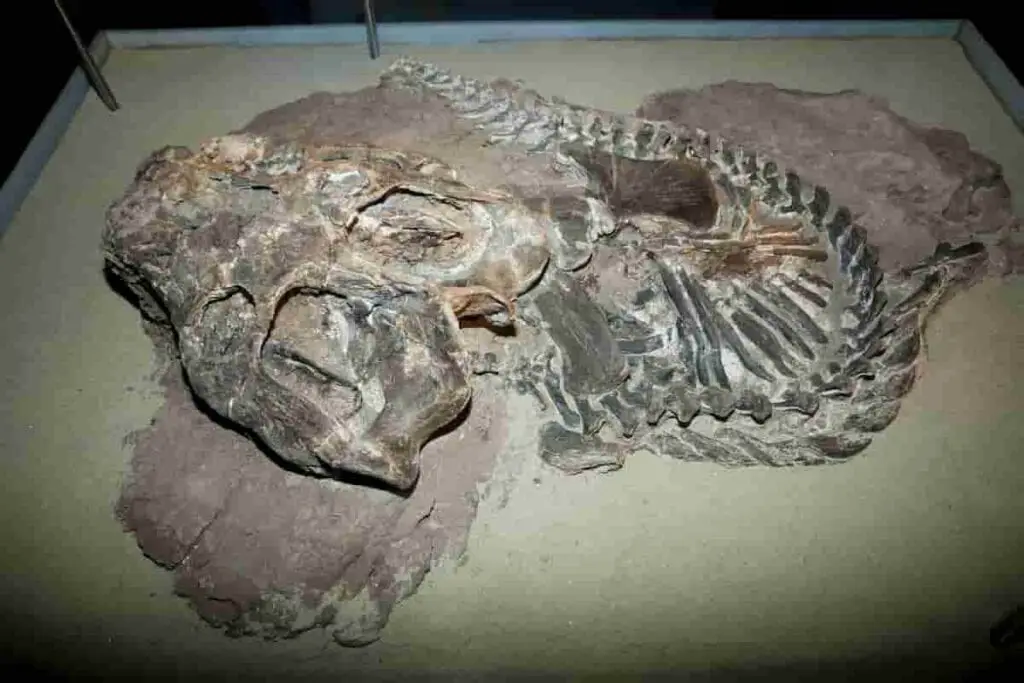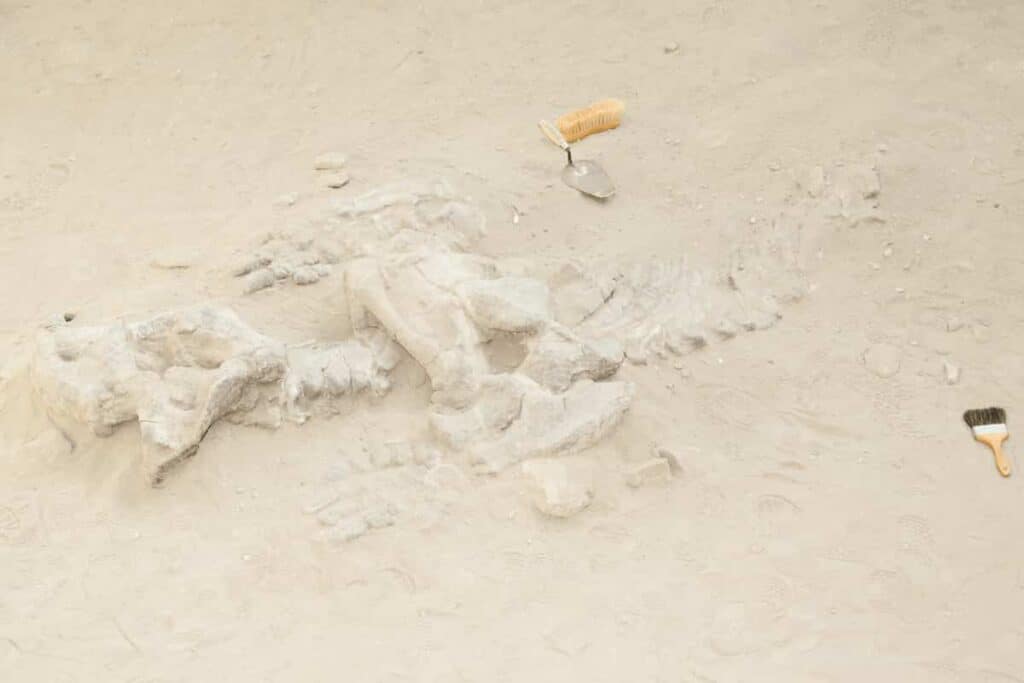According to Scientific American, as of 2021, almost 11,000 unique dinosaur fossils have been uncovered. That’s 11,000 out of possibly millions, maybe even billions or trillions. It’s hard to say. Given the wide range of fossils, are there any continents in which dinosaur fossils have not been found?

Have Dinosaur Fossils Been Found on Every Continent?
Dinosaurs lived across all continents, and thus fossils have been found on every continent as well. However, that doesn’t mean dinosaur species have been unearthed in equal measure worldwide. For example, in parts of North America, fossilization is impossible.
The study of dinosaur fossils, spread across the expanses of every continent, has become the cornerstone of understanding paleontology. Every fossil uncovered serves as a window into Earth’s history, stretching from Asia to North America, shining a light on the evolutionary journey of the mighty dinosaurs.
Table of Contents
Paleontology draws upon geology, assembling clues from the fossil record to build a picture of life during the Triassic, Jurassic, and Cretaceous periods. These eras were a time when Earth was dominated by dinosaurs, a fact captured by the fossils they left behind.
Irrespective of location, be it Asia or Antarctica, each fossil contributes to a global story of prehistoric Earth dominated by dinosaurs. As the evidence from Africa and Australia suggests, these creatures were as diverse as they were widespread, lending credence to the fact that dinosaurs indeed had a worldwide distribution.
Such a collection of fossils paints a vivid picture of a time when these majestic creatures roamed the Earth. By unlocking the secrets buried within these fossils, we deepen our understanding of Earth’s history. In essence, dinosaur fossils act as time capsules, waiting to be opened to reveal the mysteries of the Earth as it was millions of years ago.
This guide will delve deeper into the areas where fossils have yet to be uncovered. We’ll also talk about the most common dinosaurs found across the continents and which continent has the distinction of possessing the greatest number of fossils.
Let’s begin!
Where Have Dinosaur Fossils Not Been Found and Why?
As this map shows us, dinosaur fossils exist across all seven continents, including North America, South America, Africa, Europe, Asia, Antarctica, and Australia. However, that doesn’t mean dinosaur fossils have been uncovered in every corner of those continents.
North America is especially deficient in fossils, especially across the United States. Here are some states where fossils could not be found and why.
Vermont
Vermont has been home to a couple of fossils over the years, but the numbers have been very, very low. Further, none of the fossils belong to dinosaurs.
Why so few fossils? Thick rock blanketed the state beyond the eastern side of the Green Mountains. In addition, sediments here are weaker than in other parts of North America.
Paleontologists believe that Vermont housed trilobites, ostracoderms, crinoids, corals, and brachiopods during the beginning of the Paleozoic Era. The area would have been covered in shallow water at the time that was quite warm.
Rhode Island
Another east coast state without any dinosaur fossils on record is Rhode Island. That said, some plant fossils have been found that were believed to have come from coral beds scattered throughout what would later become the state.
Like Vermont, Rhode Island was an underwater zone during the Early Paleozoic Era. Trilobites would have easily survived in this environment.
Later, in the Carboniferous Period, Rhode Island shifted into a swamp. Trees here would often reach heights of 50 feet, which is so fascinating! Cockroaches and arachnids would have called this area home.
New Hampshire
Continuing the thread of east coast states with no dinosaur fossils ever uncovered is New Hampshire. It’s not only dinosaur fossils that are nonexistent here; other fossils are very hard to come by because of the metamorphic geology.
Metamorphic rock includes a protolith or original rock heated to very high temperatures, which leads to changes in its composition.

What do we know about New Hampshire during the age of dinosaurs? Well, in the Early Paleozoic Period, the shallow, warm waters that covered New Hampshire were the same found in other east coast states during this period.
Trilobites, corals, bryozoans, crinoids, and brachiopods were right at home in the shallow waters. After that, from the Mesozoic to the Cenozoic Periods, rock erosion made it impossible to find fossils.
Kentucky
The last North American state where dinosaur fossils have not been uncovered is Kentucky. Unlike the others, it is not an east coast state, as Kentucky is much further south.
Paleontologists have been able to find all nature of other fossils due to the rife sedimentary rock throughout Kentucky. Most of this rock is exposed, making digging for fossils an even more viable venture.
Due to those rocks, we know that the first fossils in Kentucky were from the Ordovician Age, which was almost 500 million years ago.
The same warm, shallow waters from the east coast spread to Kentucky, introducing crinoids, brachiopods, trilobites, and cephalopods. By the Carboniferous Period, Kentucky had become a swamp, much as was the fate of Rhode Island.
Although sadly, these states have not uncovered dinosaur fossils as of this writing, you can never say never. Since fossils of dinosaurs are being unearthed nearly every month in the 2020s, paleontology is about to enter an exciting phase!
What Dinosaur Was Found on Almost Every Continent?
Keeping in mind how common dinosaur fossils are in most of the world (including North America outside of those states), it was only a matter of time before the same dinosaur species would be unearthed across the continents.
According to this 2011 report from UK news resource Telegraph, that distinction goes to the Dicynodont.

If you’re not familiar with the Dicynodont, allow us to share some fun facts with you. The Dicynodont was in a clade known as Dicynodontia, which included anomodonts. An anomodont is a type of therapsid (that wasn’t a mammal) that lived from the Permian to the Triassic Periods.
It is not well-known, perhaps because dinosaurs from the Jurassic and Cretaceous are more popular in media and publically referred to more often. However, when researching information for this article, Dicynodontia is one genus that qualifies for being dominant on a global distribution scale.
The Dicynodont was an herbivore with a name that means “two dog tooth.” Why the nickname? This dinosaur had dual tusks and a beak with no teeth but plenty of horns.
Believed to have lived during the middle of the Permian Period about 270 million years ago through the Late Permian period 260 million years back, the Dicynodont was killed by the end-Permian extinction event.
Few therapsids survived this event. As an FYI, the Permian Extinction event was not the same as the Cretaceous-Paleogene extinction event.
Dicynodonts might have been warm-blooded, as they had vascularized bones and a large body for retaining heat. The dinosaurs could have possessed hair, but more research will have to be done there to confirm that. (Source)
Another dinosaur species that popped up across the seven continents is the Titanosaur. This sauropod from the Titanosauria group had a very long neck and was the last to possess this trait. Later, sauropods lost their neck length, likely due to an evolutionary benefit. (Source)
In the Titanosauria group are some very small sauropods and huge ones like the Patagotitan. That dinosaur weighed 76 tons. Most Titanosaurs lived during the Cretaceous Period up to 145 million years ago. (Source)
How did dinosaurs end up being found on nearly every continent, if not every single one, you ask? It’s not like Titanosaurs could fly, nor could the Dicynodont.
They didn’t need to fly. These dinosaurs didn’t even roam from continent to continent. Rather, they ended up spreading around due to no actions of their own.
In the millions of years that dinosaurs lived before going extinct, the continents shifted and sometimes even separated. Dinosaurs thus moved their homes without physically doing anything.
The dino species that died before the continents shifted had their remains deposited in one location, and the dinosaurs that died after the continents shifted had their remains deposited elsewhere. These dinosaurs were all still part of the same species, though.
It is how we have fossils of some dinosaurs on every continent!
Which Country Has the Most Dinosaur Fossils?
We’ve established that some continents have more fossils than others using that map from earlier in the article. Now let’s narrow our scope a little and assess countries.
Of all the multitude of countries worldwide, which one contains the most fossils? Well, there’s more than one, so let’s take a closer look.
United States
Even though the lion’s share of US states lacks dinosaur fossils, the country deserves to be on this list.
From Dinosaur Ridge in Colorado to the Mammoth Site in South Dakota, Petrified Forest State Park in Arizona, Fossil Butte National Monument in Wyoming, and the Morrison Formation in Colorado, the list of fossil sites goes on.
Western North America has long since been a hotspot for paleontologists eager to find dinosaur bones. Often, these experts can even unearth entire skeletons! (Source)
Argentina
The South American country of Argentina has been another goldmine for locating dinosaur fossils. More so than only fossil remains, we’ve gotten bird footprints and even dinosaur eggs in this country. Few things are more exciting as a dinosaur fan!
Some of the more renowned spots in Argentina where dinosaur fossils are located include the Anacleto Formation, the Allen Formation, the Bajo de la Carpa Formation, and the Andalhuala Formation.
Canada
The US doesn’t get all the glory of dinosaur fossils! The North American country Canada sees its fair share of fossils as well.
From Tournasian creatures at Blue Beach in Nova Scotia to Ordovician-era species at the Bobcaygeon Formation in Ontario and Cambrian dinosaurs at Kootenay National Park’s Burgess Shale in Alberta, a variety of excellent species have been unearthed on Canadian soil.
China
That dinosaur fossil boom we talked about earlier is mostly attributed to China. Lufeng in Yunnan Province has revealed Jurassic-era bones, and Zigong in the Sichuan Province recovered fossils from nearly 200 million years ago.
In Nanyang, Henan Province, paleontologists dug up stone eggs or stone gallbladders, which could be fossils of eggs.
Conclusion
Dinosaur fossils have been found on every seven continents, with some species like the Dicynodont located on each continent. North America remains one of the rifest locations for dinosaur fossils, with China another desirable place to dig.
We hope this article expands your appreciation of dinosaur fossils and where they come from!
